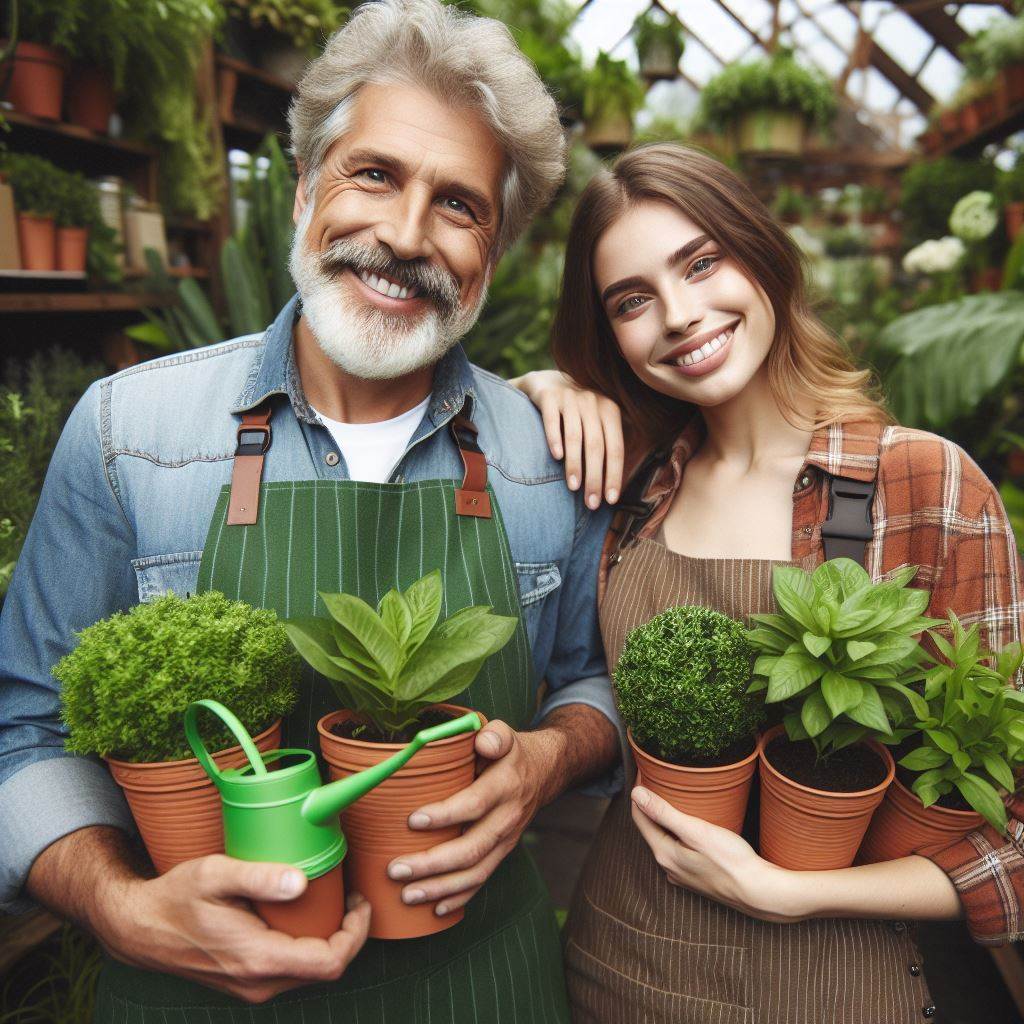Introduction
Let’s dive deeper into the world of gardening within confined spaces.
Despite limited room, you can still enjoy the freshness and flavor of homegrown herbs.
Imagine plucking basil leaves for a caprese salad or adding freshly chopped cilantro to your tacos—all from the convenience of your own shelf garden.
The significance of herbs in cooking extends beyond mere flavor enhancement.
They boast numerous health benefits, packed with vitamins, minerals, and antioxidants.
Incorporating them into your meals not only elevates taste but also promotes overall well-being.
Now, imagine creating your own herb haven right in your kitchen or balcony.
With strategic planning and proper care, you can cultivate a diverse array of herbs even in the smallest of areas.
No need for a spacious backyard—just a sturdy shelf and a bit of creativity.
Throughout this blog post, we’ll explore the intricacies of growing herbs on a shelf.
From selecting the right herbs to providing optimal growing conditions, we’ll cover everything you need to know to nurture your own mini herb garden.
Get ready to unleash your inner gardener and savor the delights of fresh, homegrown herbs.
Importance of Growing Herbs
The flavor and aroma enhancement herbs provide
- Herbs add a burst of flavor and aroma to dishes, enhancing the overall taste.
- Fresh herbs offer a more vibrant and intense flavor compared to dried ones.
- Using herbs in cooking allows for creative and unique flavor combinations.
The health benefits of using fresh herbs
- Fresh herbs are rich in vitamins, minerals, and antioxidants, contributing to a healthy diet.
- Many herbs have medicinal properties and can help alleviate various health issues.
- Adding herbs to meals can boost the immune system and promote overall wellbeing.
The cost-effectiveness of growing herbs at home
- Growing herbs at home is an economical choice, as they are expensive to buy regularly.
- It eliminates the need to buy packaged herbs, reducing your grocery expenses.
- Cultivating your own herbs ensures a constant supply, saving you money in the long run.
In fact, growing herbs at home offers numerous advantages, including enhanced flavor and aroma, health benefits, and cost-effectiveness.
By incorporating fresh herbs into our daily meals, we can elevate our culinary experiences and improve our overall wellbeing.
So why not start a mini herb garden on your shelf and enjoy the multitude of benefits it brings?
Choosing the Right Shelf for Herb Gardening
A suitable shelf or rack is essential for successful herb gardening in small areas.
Not only does it provide a designated space for your plants, but it also ensures that they receive the necessary sunlight and ventilation to thrive.
Importance of selecting a suitable shelf or rack
When choosing a suitable shelf for your herb garden, consider the materials, size, and design options available in the market.
Opting for shelves made of weather-resistant materials like metal, plastic, or treated wood can ensure their durability in various outdoor conditions.
The size of the shelf should accommodate the number of herb pots you plan to grow without overcrowding them.
Furthermore, consider the design of the shelf and how it complements your gardening space.
Some shelves have multiple tiers, which allow you to grow a larger variety of herbs in the same area.
Others come with hooks or additional storage compartments for gardening tools or supplies.
Considering the space available and the amount of sunlight required
Remember to place your shelf in an area with sufficient sunlight. Most herbs require at least six hours of direct sunlight daily to thrive.
Observe the sun trajectory in your small space and choose a location that receives the maximum amount of sunlight during the day.
Importance of sturdy and well-ventilated shelves
Lastly, prioritize the ventilation of your chosen shelf.
Herbs, like any other plants, need proper air circulation to prevent diseases and ensure healthy growth.
Stagnant air can lead to the development of molds and fungi, which can harm your herbs.
Select shelves with open designs or slatted surfaces that allow air to freely flow around your plants.
In short, choosing the right shelf for herb gardening in small areas is essential for a successful and efficient gardening experience.
The suitable shelf should fit the available space, provide adequate sunlight exposure, and offer sturdy and well-ventilated support for your herbs.
Consider your specific gardening needs, explore the available options, and enjoy the convenience of having fresh herbs at your fingertips.
Selecting Herbs for Shelf Gardening
Popular Herbs for Small Spaces
Including these popular herbs in your shelf garden not only adds beauty to your small space but also provides you with fresh flavors to elevate your culinary creations.
Don’t let limited space deter you from starting your own herb garden.
With the right selection of herbs, proper care, and some creativity, you can have a thriving and functional mini-garden right at your fingertips.
Remember to choose herbs that are suitable for small spaces, such as basil, chives, mint, oregano, parsley, rosemary, and thyme.
These herbs can be grown in pots or containers, making them ideal for shelf gardening.
Growth Requirements and Care Tips
Each herb has specific growth requirements. Basil, for example, prefers well-drained soil and full sunlight.
Regular watering and pinching off flower buds will help promote bushier growth.
Chives, on the other hand, thrive in partial shade and require regular watering.
Harvest the leaves by cutting them close to the base.
Transform Your Agribusiness
Unlock your farm's potential with expert advice tailored to your needs. Get actionable steps that drive real results.
Get StartedMint, known for its refreshing aroma, grows well in containers. It prefers moist soil and partial shade.
Pruning regularly will help control its growth and prevent it from spreading too much.
Oregano, a staple in Italian cuisine, needs well-drained soil, full sunlight, and moderate watering.
Parsley can be grown in small pots and needs well-drained soil. It thrives in partial shade and requires moderate watering.
Harvest the outer leaves first, allowing the plant to continue growing.
Rosemary, a woody perennial, requires well-drained soil, full sunlight, and minimal watering.
Trim it regularly to maintain its shape.
Thyme, with its delicate foliage, is perfect for small spaces. It needs well-drained soil and full sunlight.
Moderate watering and pruning after flowering will encourage new growth.
Versatile and Multipurpose Herbs
In addition to their growth requirements, these herbs also serve versatile purposes in the kitchen.
Basil can be used in sauces, salads, and pesto. Chives enhance the taste of soups, salads, and omelets.
Mint is great for making refreshing drinks like mojitos, teas, and cocktails.
Oregano is perfect for seasoning pizzas, pasta sauces, and roasted vegetables.
Parsley adds freshness and garnish to salads, soups, and pasta dishes.
Rosemary complements roasted meats, potatoes, and grilled vegetables.
Thyme enhances the taste of chicken, fish, and roasted vegetables.
By incorporating these versatile and multipurpose herbs into your dishes, you’ll elevate the flavors and create delicious meals.
Enjoy the convenience of having these fresh herbs within arm’s reach, ready to be plucked and added to your culinary creations.
So, start your shelf garden today and experience the joy of growing your own herbs in even the smallest of spaces. Happy gardening!
Read: Apartment Herb Gardening: Freshness on Hand
Setting Up the Shelf Herb Garden
Achieving a successful herb garden is not limited to vast outdoor spaces.
Even in small areas, you can create a thriving herb garden by setting up a shelf garden.
Process of Setting Up a Shelf Garden
- Choose a suitable location for your shelf garden, preferably near a window for proper sunlight exposure.
- Measure and determine the dimensions of your shelf, ensuring it can accommodate the number of herbs you wish to grow.
- Install the shelf securely on a wall or place it on a sturdy surface, making sure it can support the weight of the containers and herbs.
- Consider using adjustable shelves to accommodate different plant heights and provide enough space for each herb to grow.
Use of Containers or Pots for Individual Herbs
- Opt for containers or pots that have drainage holes to prevent waterlogging, which can lead to root rot.
- Choose pots with adequate depth to allow herb roots to establish and grow healthily.
- Ensure the containers are made of durable and lightweight materials for easy handling and transportation.
- Consider using recycled or repurposed containers for an eco-friendly approach.
Tips on Arranging the Herbs for Proper Growth and Access
- Group herbs with similar light and water requirements together to ensure they receive the appropriate conditions.
- Place taller herbs at the back of the shelf to prevent shading smaller ones and maximize sunlight exposure.
- Consider arranging herbs according to their growth habit, with sprawling herbs at the edges and upright herbs towards the center.
- Label each herb for easy identification and to keep track of their specific care needs.
- Leave enough space between each herb to avoid overcrowding, which can impede airflow and increase the risk of diseases.
- Rotate the containers regularly to ensure all sides of the herbs receive equal light exposure and grow uniformly.
- Provide proper support for climbing or trailing herbs by using stakes, trellises, or plant hangers.
- Keep the shelf garden clean and free from debris to prevent pests and diseases from spreading.
- Regularly check the moisture level of the soil and water the herbs accordingly, avoiding overwatering or underwatering.
- Remember to prune and harvest the herbs regularly to promote bushy growth and encourage a continuous harvest.
Setting up a shelf herb garden allows you to enjoy fresh herbs even in limited spaces.
By following these steps, you can create a compact and accessible garden that adds flavor and beauty to your home.
Read: Compact Herb Gardening: A Step-by-Step Guide

Caring for Shelf Herbs
Watering Requirements for Herbs on a Shelf
- Water herbs thoroughly when the top inch of the soil feels dry.
- Ensure water reaches the root zone, but avoid waterlogging or standing water.
- Use a watering can or spray bottle to provide even moisture distribution.
- Adjust watering frequency based on the herb’s specific needs.
Importance of Proper Drainage and Avoiding Overwatering
- Select pots or containers with drainage holes to prevent water from accumulating.
- Avoid using saucers or trays that can trap excess water.
- Overwatering can lead to root rot and other diseases.
- Monitor soil moisture levels by checking the soil’s dampness with your finger.
- Provide adequate drainage to prevent waterlogged soil.
Tips for Pruning, Fertilizing, and Addressing Pests or Diseases
- Regularly prune herbs to maintain their shape and encourage bushy growth.
- Remove any yellow or dead leaves to promote healthy foliage.
- Harvest herbs regularly to prevent them from becoming leggy or sprawling.
- Fertilize herbs every 4-6 weeks with a balanced liquid fertilizer diluted to half strength.
- Monitor herbs for common pests like aphids, spider mites, and whiteflies.
- Use organic pest control methods, such as neem oil or insecticidal soap, if necessary.
- Identify and address any signs of diseases promptly to prevent them from spreading.
- Common herb diseases include powdery mildew, black spot, and root rot.
- Adjust watering and air circulation to prevent fungal infections.
- If a herb is severely affected, consider removing and replacing it to protect other plants.
Caring for herbs on a shelf requires attention to their watering, drainage, pruning, fertilizing, and pest or disease management.
By following the tips provided, gardeners can maintain healthy and thriving herb plants in small areas.
Read: Urban Herb Farming: Tips for Your Window Ledge
Harvesting and Using Shelf Herbs
Harvesting herbs for optimal flavor
- Harvest herbs in the morning, after the dew has dried but before the sun becomes too hot.
- Pinch off the outer leaves of the herb plants, starting from the top and moving downward.
- Cut herbs with sharp, clean scissors or pruning shears, avoiding any flowers or seed heads.
- Leave at least one-third of the plant intact to ensure continued growth and production.
- Wash the harvested herbs gently in cool water to remove any dirt or insects.
- Pat the herbs dry with a clean towel or use a salad spinner to remove excess moisture.
Preserving and storing harvested herbs
- Air-drying: Tie small bunches of herbs together with twine and hang them upside down in a well-ventilated area.
- Dehydrating: Use a food dehydrator or an oven set to a low temperature to remove moisture from herbs.
- Freezing: Chop herbs finely and place them in ice cube trays, covered with olive oil or water.
- Making herb-infused oils: Fill sterilized jars with herbs and cover them with a neutral oil like olive or sunflower oil.
- Creating herb vinegars: Fill a clean jar halfway with herbs and pour heated white or red wine vinegar over them.
Creative recipes and ideas for using harvested herbs
- Herb butter: Mix chopped herbs like basil, parsley, and chives into softened butter for a flavorful spread.
- Herbal teas: Steep herbs like mint, chamomile, or lavender in hot water for a soothing and aromatic beverage.
- Infused cocktails: Muddle herbs with fresh fruits, add spirits like vodka or rum, and top with soda for unique drinks.
- Herb-infused salts: Blend herbs with coarse sea salt and use the mixture to season dishes.
- Herb-infused syrups: Simmer herbs in water and honey or sugar to create flavorful syrups for desserts or beverages.
- Herb-infused desserts: Add herbs like rosemary or thyme to baked goods, ice creams, or fruity desserts for a surprising twist.
- Herb-infused oils and dressings: Blend herbs with oil, vinegar, and other ingredients to create flavorful dressings for salads.
In essence, harvesting herbs at the right time and preserving them properly ensures optimal flavor and continuous supply.
With creative recipes and ideas, one can fully utilize the harvested herbs in various culinary ventures, enhancing the overall dining experience.
Transform Your Agribusiness Online Presence
Stand out with compelling content tailored to engage your audience and drive results. From blog posts to social media, we’ll create what your business needs to grow.
Get StartedRead: Herb Gardening 101: Perfect for Tiny Yards
Troubleshooting Common Issues in Shelf Herb Gardening
A successful shelf herb garden can be a delight for any gardener, but like any form of gardening, it comes with its own set of challenges.
In this section, we will discuss common problems that you may encounter while growing herbs on a shelf and offer effective solutions to overcome them.
Common problems and challenges in growing herbs on a shelf
- Insufficient sunlight: Lack of proper sunlight can hamper the growth of herbs.
- Poor drainage: Excess water retention can lead to root rot and other fungal diseases.
- Inadequate airflow: Lack of air circulation can promote the growth of mold and mildew.
- Pest infestation: Common pests like aphids, mites, and whiteflies can attack your herbs.
- Overwatering or underwatering: Finding the right balance of watering can be tricky.
- Soil quality: Poor soil composition can affect the overall health and growth of your herbs.
Understanding these common problems is crucial for maintaining a thriving shelf herb garden.
Let’s explore the solutions to each of these challenges.
Offer solutions for issues such as inadequate sunlight or pests
- Insufficient sunlight: Ensure that your shelf is placed in a location that receives at least 6-8 hours of direct sunlight. You can also use artificial grow lights to supplement natural light.
- Poor drainage: Choose well-draining pots or add drainage holes to existing containers. Use a lightweight potting mix specifically formulated for herbs.
- Inadequate airflow: Place a small fan near your shelf herb garden to improve air circulation. Regularly open windows or use a dehumidifier in excessively humid environments.
- Pest infestation: Monitor your herbs regularly for signs of pests. Use organic insecticidal soaps or neem oil to control the infestation. Introduce beneficial insects like ladybugs or lacewings.
- Overwatering or underwatering: Stick your finger into the soil to determine the moisture level. Water only when the top inch of soil feels dry. Avoid drowning your herbs or letting them wilt due to dryness.
- Soil quality: Use a well-balanced potting mix enriched with organic matter. Regularly amend the soil with compost or organic fertilizers to provide essential nutrients.
Resources or references for further assistance
If you need further assistance or more in-depth information, these resources can be helpful:
- Books: “The Herb Gardener’s Essential Guide” by Sandra Kynes
- Online forums and communities: Join herb gardening forums to connect with experienced gardeners and seek advice.
- Local gardening centers: Visit your nearby gardening centers and consult experts for personalized guidance.
- Websites and blogs: Explore online articles and blogs dedicated to herb gardening for a wealth of valuable information.
- YouTube channels: Watch instructional videos on herb gardening from reputable YouTube channels.
Remember, gardening is a continuous learning process, and troubleshooting common issues is part of the journey.
Don’t get discouraged if you face challenges along the way.
With patience, effort, and the right knowledge, your shelf herb garden will flourish.
Conclusion
Recap the benefits and possibilities of herb gardening in small areas
Compact herb gardening maximizes space, providing fresh, flavorful herbs for cooking and medicinal purposes.
It fosters a connection to nature, even in urban settings.
Encourage readers to start their own shelf herb gardens
Begin your herb journey today! With minimal space and effort, you can cultivate an array of aromatic herbs.
Embrace the satisfaction of growing your own ingredients.
Offer final tips and advice for successful shelf herb gardening
Ensure proper drainage for your pots and adequate sunlight for your herbs.
Regular pruning promotes growth and prolongs harvests.
Experiment with different herbs and enjoy the versatility they bring to your culinary creations!




